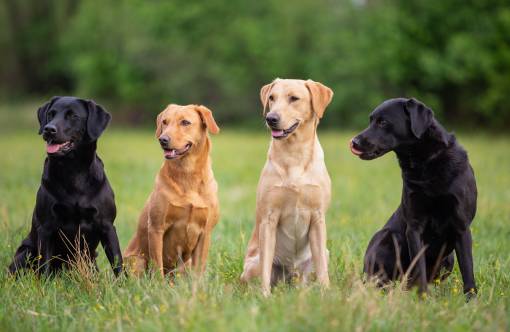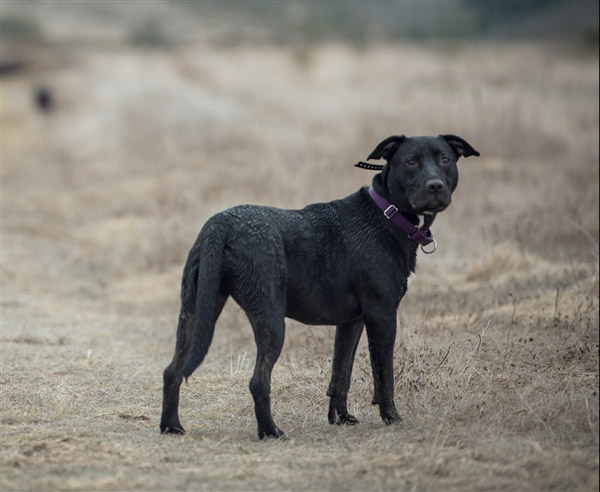Connect with a verified veterinarian in minutes. Licensed vets are available 24/7 to answer your questions. No need to worry about your furry family member.
Labradors are one of the most popular dogs in the US! And there’s a good reason for that! These dogs are very friendly with everyone, and they’re highly intelligent! They also love to have fun! Who couldn’t fall in love with a Lab? Even people who are not pet parents easily recognize a Lab from all other dog breeds.
Along with their amazing personalities, Labs come in a wide variety of colors! Have you ever wondered what the recognized Lab colors are or what colors Labs come in? If so, read on to learn more about Labs and their brilliant colors!
Three Recognized Colors for Labs
According to the AKC and the Kennel Club (in the UK), Labradors have three recognized and accepted colors. The three recognized colors are:
- Black
- Brown
- Yellow
While there are three accepted and recognized Lab colors, these beautiful dogs come in a wide range of hues and shades! For instance, it’s possible to find Labs that are almost white, while others are a deep red, with other colors in between! So, what causes all these different Labrador colors?
We’ll get to that in a minute. First, did you know there was an original Lab color? Do you know what it was?
The Original Lab Color
Originally, all Labs were black, and this was the only accepted color for the breed! It was once the practice for breeders to euthanize chocolate and yellow Lab puppies. However, genetics had another thought about Lab colors!

Review symptoms, medications & behavior to keep your pets healthy with a Vet Online in just minutes.
Ask a Vet Live NowWhere Do Lab Colors Come From?
Lab colors are all determined by the dogs’ genes and pigment. For instance, black and brown Labs derive their color from a pigment called eumelanin. If a Lab has a lot of eumelanin, then he will be black. However, if they have less, the dog will be brown. This is where genes come into play.
Genes can be a complex subject, so we’ll just keep it as simple as possible. Back to the black and brown Labs, the dogs’ genes determine the amount of eumelanin they have. The amount of eumelanin is determined by the big B genes.
The B genes are dominant and have the code for high amounts of eumelanin that causes the black coat. There’s also a recessive b gene that codes for lower amounts of eumelanin, which results in a chocolate brown coat.
Dogs who inherit two BB (both dominant genes) from each parent will be black. However, it’s also possible for a black Lab to have BB or Bb genes and still be black. However, a dog with a chocolate coat inherits two bb recessive genes. How cool is that?
Now, let’s consider yellow Labs. These dogs’ coat color is determined by the E (dominant) gene. The yellow Lab inherits genes from each parent and has EE genes for a yellow coat. However, the E gene also determines whether the B gene is expressed or not (allowed to come through).
The E genes are dominant and do not interfere with the B genes. However, the e gene is recessive and can mask the B gene. This masking causes the yellow coat in yellow Labs.
Labradors with EE or Ee will be black or chocolate (depending on their B genes); however, dogs with the ee genes will have a yellow coat.
- EEBB, EeBB, EeBb, EEBb genes cause a Lab to be black
- EEbb, Eebb dogs are chocolate
- eeBB, eeBb, and eebb dogs are yellow (breeding two yellow Labs always produces yellow puppies)
Are you confused yet? Well, here’s another one! Two chocolate Labs can have chocolate or yellow puppies! And a pair of black Labs can have black, yellow, or chocolate puppies. But what happens if you mix Labs with other dog breeds? Well, the genetics become even more convoluted!
And we’ve not yet even considered dilute genes. There are also D genes that can be D or d. D is dominant and results in an un-diluted coat; however, d is a recessive gene that causes a diluted coat.
Here’s an example! A chocolate Lab who has DD genes will be chocolate. However, a chocolate Lab with dd would have a color that looks like diluted chocolate. These dogs look more silver. The same dilution can happen in yellow Labs, too, to make them have a more champagne color, or it can also result in charcoal Labs.
Phew! We said this was a little complicated! When it comes to breeders, some choose to run genetic tests on their dogs to produce colors with expected colors. However, there are also breeders who choose to breed the Labs and see what color puppies result! It’s all a wild game of genetics!
With this basic understanding of Lab colors, let’s move on to taking a look at each of the color possibilities in Labs!
Labrador Colors
Black Lab
When you see a black Lab, chances are he’s all black. However, black Labs may have a few white hairs here and there. When you see this, the white hairs are caused by genetics from an ancestor called the St. John’s water dog. These dogs had a lot of white in their fur.
The black Lab is the most common color for this dog breed, with almost half of all Labs being black. As noted earlier, the first black Labs were the recognized and acceptable color. That’s because black was a great color for hunting.
This dark coloring helped the dogs blend into their surroundings, giving them a “stealthy” ability when hunting. These dogs tend to have the best hunting instincts because black Labs were bred for hunting.
Some pet parents also say that black Labs are the calmest and most loving of all Lab colors. However, there are no scientific studies backing up this claim.
Chocolate Labs
Chocolate Labs are one of the rarest of the three Lab colors. These dogs are not often used for hunting; instead, they’re used in dog shows. The color of these dogs is stunning and can vary.
Some dogs have a deep, rich chocolate brown, and there are others that are a dark brown (sometimes described as liver). There are also chocolate labs who have a reddish color in their brown fur.
Some pet parents say their chocolate Labs are a little on the mischievous side, and they tend to have more energy. These dogs are sometimes difficult to train and are not often used as service dogs. But no matter their personalities, brown Labs are beautiful in the shades of brown they can be.
There is one downside to chocolate Labs. They do seem to have more health issues than Labs of other colors. Some of these are serious and can make the dogs’ lives shorter. However, other conditions are only minor. Even so, chocolate Labs live 10% shorter lives than Labs of other colors.
Yellow Labs
Yellow Labs are beautiful, yet they’re not the most popular color Lab! Even so, these dogs are highly prized by their pet parents. They say yellow Labs are more friendly and outgoing than Labs of other colors.
It’s interesting to note that yellow Labs are the ones you most often see in movies. They’ve become popular over the years and are often used as service dogs, search & rescue, and even as therapy dogs.
Their yellow coats can fall across a spectrum, too. Some of these beautiful dogs can be a light brown or tan, while others are described as “lemon” yellow. Cream-colored Labs are also included in the yellow spectrum. And we can’t forget fawn Labs. These dogs are a little darker, but they’re not red.
Silver Labs
Silver Labs are another rare color found in this dog breed. The dogs are a light grey to blue that looks more silver. These dogs are sometimes mistaken for Weimaraners because of their silver coats.
Silver Labs have a dilute gene that masks the chocolate color. So, the dogs come out a silver rather than chocolate color. However, some silver Labs are even said to look blue! What’s interesting is this is the same color dilution that’s found in yellow and black labs. Diluted yellows are called champagne, while diluted black Labs are called charcoal.
While these dogs are beautiful and rare, they also tend to suffer more health issues than Labs of other colors. Some of these dogs can develop color dilution alopecia that causes itchy skin and patchy fur.
Fox Red Lab
The fox red Lab has the same genetics as a yellow Lab; however, they have a deeper yellow or brown shade to their coat. When you see a red fox Lab, the brown in their coat looks like a reddish color that strongly resembles a fox!
Fox red Labs are said to be extremely friendly and loving. It’s said that Clifford, the big red dog character, was based on a fox red Lab.
While many pet parents love this red color, the AKC doesn’t. They don’t recognize fox red Labs and instead register these dogs as yellow Labs. In competitions, judges see this coloration as a fault in the breed, making it highly unlikely that such a dog would win a competition.
Then there are people who believe the red fox Lab is not purebred but a crossbreed. They believe the Lab has been crossed with a Golden Retriever. However, that’s not the case.
White Labs
White Labs are another variation of the yellow Lab. Their genetics is the same; they just have a paler color. White labs are actually the lightest possible shade of yellow and look almost white. These dogs may also have brown or yellow ears and paws that are darker than the rest of the coat.
Pet parents say their white Labs are kind and love everyone! For this reason, they don’t make very good watchdogs.
Frequently Asked Questions
In this section, we’ll take a look at some FAQs about Labs and their colors!
1. Can You Get All Three Lab Colors from Two Black Dogs?
Yes, that’s entirely possible! Here’s a quick chart showing how that can happen
Parents’ Possible Genotypes
|
Black Lab Parent 1 |
Black Lab Parent 2 | ||||
| EEBB | EEBb | EeBB | EeBb | ||
| EEBB | Puppies are black | Puppies are black | Puppies are black | Puppies are black | |
| EEBb | Puppies are black | Puppies can be black and chocolate | Puppies can be black and yellow | Puppies can be black and yellow | |
| EeBB | Puppies are black | Puppies are black | Puppies can be black & yellow | Puppies can be black and yellow | |
| EeBb | Puppies are black | Puppies can be black and chocolate | Puppies can be black and yellow | Puppies can be black, chocolate, and yellow | |
To have a mix of all three colors, both parents must have EeBb genotype.
2. What Color is Best for Labs?
There aren’t many scientific studies to back these claims; however, if we go by what Lab pet parents have to say, then:
- Black Labs are the most athletic and best at hunting; pet parents also say these are the calmest Labs
- Silver Labs are the rarest color
- Chocolate Labs seem to win most competitions
- Yellow Labs are said to be the friendliest
In the end, does it really matter what color a Lab is? We don’t think so. No matter what color they happen to be, this dog breed is friendly, intelligent, athletic, and loves you back with a full heart!
It all comes down to the dog’s genetics, upbringing, the environment they live in, their training, and socialization. These are the most determining factors when it comes to a dog’s personality, rather than the dog’s color.
Summing It Up
No matter how you look at it, each Lab color is amazing and beautiful. Each color is gorgeous. And if you’re not planning on showing your Lab, then his color doesn’t really matter at all.
So, if you’re looking to become a Lab pet parent, then choose a dog based solely on his personality rather than his color. When you adopt a Lab, you’re going to have a wonderful companion for years to come, no matter what color he is!
Connect with a verified veterinarian in minutes. Licensed vets are available 24/7 to answer your questions. No need to worry about your furry family member.

Julie
Julie is a graduate of the University of North Carolina, Wilmington, where she studied Animal science. Though contrary to the opinion of her parents she was meant to study pharmacy, but she was in love with animals especially cats. Julie currently works in an animal research institute (NGO) in California and loves spending quality time with her little cat. She has the passion for making research about animals, how they survive, their way of life among others and publishes it. Julie is also happily married with two kids.
Review symptoms, medications & behavior to keep your pets healthy with a Vet Online in just minutes.
Ask a Vet Live Now




